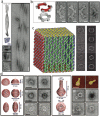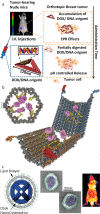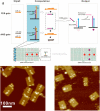DNA Origami: Folded DNA-Nanodevices That Can Direct and Interpret Cell Behavior
- PMID: 26840503
- PMCID: PMC4945425
- DOI: 10.1002/adma.201504733
DNA Origami: Folded DNA-Nanodevices That Can Direct and Interpret Cell Behavior
Abstract
DNA origami is a DNA-based nanotechnology that utilizes programmed combinations of short complementary oligonucleotides to fold a large single strand of DNA into precise 2D and 3D shapes. The exquisite nanoscale shape control of this inherently biocompatible material is combined with the potential to spatially address the origami structures with diverse cargoes including drugs, antibodies, nucleic acid sequences, small molecules, and inorganic particles. This programmable flexibility enables the fabrication of precise nanoscale devices that have already shown great potential for biomedical applications such as: drug delivery, biosensing, and synthetic nanopore formation. Here, the advances in the DNA-origami field since its inception several years ago are reviewed with a focus on how these DNA-nanodevices can be designed to interact with cells to direct or probe their behavior.
Keywords: DNA origami; biosensing; drug delivery; nanoparticles; nanopores.
© 2016 WILEY-VCH Verlag GmbH & Co. KGaA, Weinheim.
Figures






Similar articles
-
Synthesis of DNA Origami Scaffolds: Current and Emerging Strategies.Molecules. 2020 Jul 26;25(15):3386. doi: 10.3390/molecules25153386. Molecules. 2020. PMID: 32722650 Free PMC article. Review.
-
Organizing DNA origami tiles into larger structures using preformed scaffold frames.Nano Lett. 2011 Jul 13;11(7):2997-3002. doi: 10.1021/nl201603a. Epub 2011 Jun 23. Nano Lett. 2011. PMID: 21682348 Free PMC article.
-
Nanopores formed by DNA origami: a review.FEBS Lett. 2014 Oct 1;588(19):3564-70. doi: 10.1016/j.febslet.2014.06.013. Epub 2014 Jun 10. FEBS Lett. 2014. PMID: 24928438 Review.
-
Nanomechanical molecular devices made of DNA origami.Acc Chem Res. 2014 Jun 17;47(6):1742-9. doi: 10.1021/ar400328v. Epub 2014 Apr 29. Acc Chem Res. 2014. PMID: 24772996
-
DNA Origami in the Quest for Membrane Piercing.Chem Asian J. 2022 Oct 4;17(19):e202200591. doi: 10.1002/asia.202200591. Epub 2022 Aug 24. Chem Asian J. 2022. PMID: 35947734 Review.
Cited by
-
Accessing and Assessing the Cell-Surface Glycocalyx Using DNA Origami.Nano Lett. 2021 Jun 9;21(11):4765-4773. doi: 10.1021/acs.nanolett.1c01236. Epub 2021 May 24. Nano Lett. 2021. PMID: 34030445 Free PMC article.
-
Smart cancer therapy with DNA origami.Nat Biotechnol. 2018 Mar 6;36(3):234-235. doi: 10.1038/nbt.4095. Nat Biotechnol. 2018. PMID: 29509744 No abstract available.
-
DNA-Based Nanomaterials as Drug Delivery Platforms for Increasing the Effect of Drugs in Tumors.Cancers (Basel). 2023 Apr 5;15(7):2151. doi: 10.3390/cancers15072151. Cancers (Basel). 2023. PMID: 37046816 Free PMC article. Review.
-
DNA nanotechnology for nucleic acid analysis: multifunctional molecular DNA machine for RNA detection.Chem Commun (Camb). 2016 Dec 6;52(99):14318-14321. doi: 10.1039/c6cc06889h. Chem Commun (Camb). 2016. PMID: 27886299 Free PMC article.
-
Real-time magnetic actuation of DNA nanodevices via modular integration with stiff micro-levers.Nat Commun. 2018 Apr 13;9(1):1446. doi: 10.1038/s41467-018-03601-5. Nat Commun. 2018. PMID: 29654315 Free PMC article.
References
Publication types
MeSH terms
Substances
Grants and funding
LinkOut - more resources
Full Text Sources
Other Literature Sources

